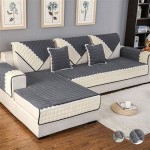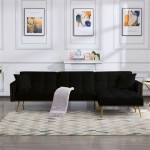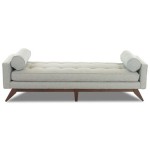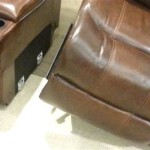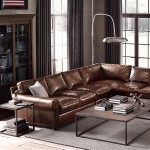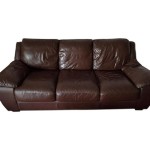Sofa Without Backrest: Design, Functionality, and Applications
A sofa without a backrest, often referred to as a backless sofa, bench, or settee, represents a distinctive furniture piece that challenges conventional seating designs. These sofas prioritize versatility, visual openness, and often serve multiple functions within a living space. Understanding their characteristics, benefits, and appropriate uses is crucial for interior designers and homeowners seeking to incorporate them effectively into diverse settings.
The fundamental feature of a backless sofa is, predictably, the absence of a backrest. This design departure alters the seating posture, encourages active sitting, and promotes interaction within the room. Backless sofas commonly feature elongated cushions or upholstered platforms supported by various base structures, ranging from solid wood frames to metal legs. The overall aesthetic can vary considerably, from minimalist and modern to more ornate and traditional, allowing for seamless integration into a wide range of interior design styles.
Key Benefits of a Backless Sofa
One of the primary advantages of a sofa without a backrest is its enhanced spatial efficiency. By eliminating the visual barrier of a traditional sofa back, the room appears larger and more open. This is particularly beneficial in smaller apartments or rooms where maximizing visual space is essential. The lack of a backrest also allows light to flow more freely throughout the room, contributing to a brighter and more airy ambiance. This design element helps to reduce visual clutter and fosters a sense of spaciousness that can be otherwise difficult to achieve.
Moreover, a backless sofa can serve as a versatile divider within an open-plan living area. It can subtly delineate different zones, such as separating a living room area from a dining space, without completely obstructing the view or creating a sense of confinement. This is especially valuable in contemporary homes where open-concept layouts are prevalent. The low profile of the backless sofa ensures that the visual connection between spaces remains intact, promoting a cohesive and harmonious environment.
Another key advantage stems from the increased flexibility in seating arrangements. Because there is no defined "front" or "back," individuals can sit on either side of the sofa, facilitating conversation and interaction. Guests are not forced to face a specific direction, leading to a more fluid and adaptable social setting. This can be particularly appealing for social gatherings or family events where a more informal and inclusive seating arrangement is desired.
Design Considerations for Backless Sofas
When selecting a backless sofa, several design considerations are paramount. The height of the sofa is crucial for ensuring comfortable seating. If the sofa is too low, it can be difficult to get up from or maintain proper posture. Conversely, if it is too high, it may feel awkward and out of proportion with the surrounding furniture. A height that aligns with typical chair or sofa seating heights is generally recommended.
The material and construction quality are equally important. The upholstery should be durable, stain-resistant, and comfortable to the touch. Fabrics such as linen, wool, or high-quality synthetics are often preferred for their longevity and aesthetic appeal. The frame of the sofa should be sturdy and well-constructed to withstand regular use. Solid wood frames are often considered the most durable option, while metal frames can offer a more modern and lightweight alternative.
The overall style of the backless sofa should complement the existing décor of the room. Whether choosing a minimalist design with clean lines or a more ornate style with decorative detailing, the sofa should integrate seamlessly into the overall aesthetic. The color and pattern of the upholstery should also be carefully considered to ensure that it harmonizes with the surrounding colors and patterns. Neutral colors such as gray, beige, or white are versatile choices that can be easily incorporated into various design schemes, while bolder colors or patterns can be used to create a focal point.
Furthermore, it's important to consider the need for additional support. Since backless sofas do not provide lumbar support, accent pillows are often necessary to ensure comfortable seating. The number and size of the pillows should be carefully chosen to provide adequate support without overwhelming the sofa or detracting from its minimalist design. These pillows can also serve as an opportunity to introduce color, pattern, and texture, further enhancing the overall aesthetic of the room.
Applications of Backless Sofas in Various Settings
Backless sofas find diverse applications in various settings, ranging from residential homes to commercial spaces. In living rooms, they can serve as a stylish and functional seating option, particularly in smaller spaces where maximizing visual openness is crucial. They can be placed against a wall or float in the middle of the room to define different zones. When positioned against a wall, the absence of a backrest allows artwork or other decorative elements to be prominently displayed above the sofa. This creates a visually appealing backdrop and adds personality to the space.
In bedrooms, a backless sofa can serve as a chic and comfortable bench at the foot of the bed. This provides a convenient place to sit while getting dressed or putting on shoes, and it also adds a touch of elegance to the room. The sofa can also be used as a decorative element to break up the monotony of a long, narrow bedroom. By placing the sofa perpendicular to the bed, it can create a visual break and define a small seating area within the room. This can be particularly appealing in larger bedrooms where there is ample space to create a more multi-functional environment.
Furthermore, backless sofas are increasingly being used in commercial spaces such as waiting rooms, lobbies, and lounges. Their minimalist design and spatial efficiency make them ideal for high-traffic areas where maximizing seating capacity is essential. The ability for individuals to approach and sit from any direction promotes a more fluid and welcoming environment. In these settings, durable and easy-to-clean upholstery is particularly important to ensure that the sofa remains in good condition despite heavy use. Leather or high-performance fabrics are often preferred for their resistance to stains and wear.
In outdoor settings, weather-resistant backless sofas can enhance patios, decks, and gardens. Constructed from materials such as teak, aluminum, or durable plastics, these sofas can withstand the elements and provide comfortable seating for outdoor gatherings. The absence of a backrest ensures that the view is not obstructed, allowing individuals to fully enjoy the surrounding scenery. Outdoor backless sofas are often paired with cushions and pillows made from weather-resistant fabrics to provide additional comfort and style.
Choosing the right size is another crucial factor. The length and width of the sofa should be proportional to the size of the room and the surrounding furniture. A sofa that is too large can overwhelm the space, while a sofa that is too small may look insignificant. Consider the number of people who will typically be using the sofa and choose a size that can comfortably accommodate them. It is often helpful to measure the space where the sofa will be placed and use masking tape to visualize the dimensions before making a purchase.
Maintaining a clean and uncluttered look around the backless sofa is essential to maximize its visual impact. Avoid overcrowding the space with excessive furniture or accessories. A few carefully chosen decorative elements, such as a coffee table, a floor lamp, or a potted plant, can enhance the overall aesthetic without overwhelming the space. Regularly dusting and vacuuming the sofa will help to keep it looking its best and prevent the accumulation of dirt and dust.
Integration with Interior Design Styles
The versatility of the backless sofa allows it to be seamlessly integrated into various interior design styles. In minimalist and modern interiors, a sleek and simple backless sofa with clean lines and neutral colors can enhance the overall aesthetic. Pair it with geometric-shaped pillows and a minimalist coffee table to create a cohesive and understated look. The focus should be on simplicity, functionality, and the use of high-quality materials.
In bohemian and eclectic interiors, a more ornate backless sofa with textured upholstery and decorative detailing can add a touch of personality and charm. Layer it with colorful pillows and throws to create a cozy and inviting space. Incorporate vintage or antique furniture pieces and unique accessories to create a layered and eclectic look. The key is to create a sense of comfort, creativity, and individual expression.
In traditional and classic interiors, a backless sofa upholstered in a luxurious fabric such as velvet or brocade can add a touch of elegance and sophistication. Pair it with classic-style pillows and a traditional coffee table to create a cohesive and timeless look. Consider incorporating antique or reproduction furniture pieces and decorative accessories to enhance the overall aesthetic. The focus should be on quality, craftsmanship, and the use of timeless design elements.
Ultimately, the success of incorporating a backless sofa into any interior design scheme depends on careful planning, attention to detail, and a clear understanding of the desired aesthetic. By considering the key factors discussed above, homeowners and interior designers can effectively leverage the unique advantages of this versatile furniture piece to create a stylish, functional, and visually appealing living space.

Green Modern 3 Seater Without Back Sofa Living Room 5 Inch

Up 3 Seater Without Backrest Architonic Living Room Decor Guide Bed Stool Bedroom Furniture Design

Grey Wooden 2 Seater Sofa Without Back

Pin On Interior Design

Leatherette One Seater Sofa

Ran Lounge Couch The Home Dekor Upholstered Daybed Sofa Set

25 Types Of Sofas Explained Architectural Digest

Ast International 3 Seater Wooden Diwan Sofa Without Storage

20 Best Sofas For Small Living Rooms Plus Expert Advice

Arcticscorpion Modern Folding Floor Sofa Bed 2 Pillows Adjustable Back Support Polyester Burgundy Finish Com

